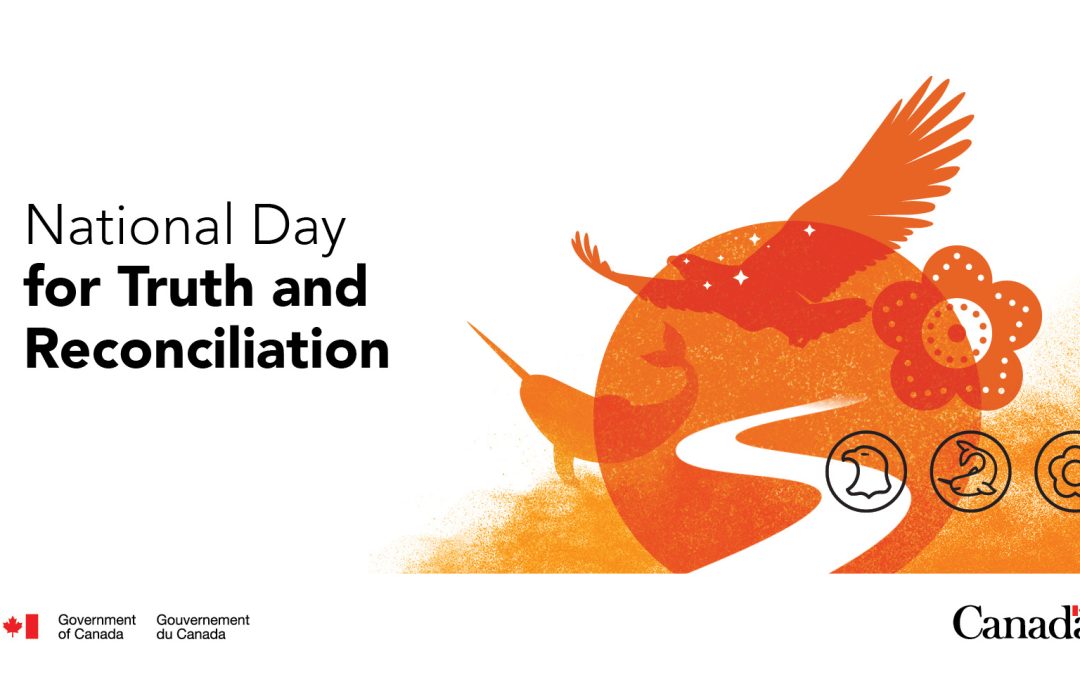Beginning in 2021, Canadians mark Sept. 30 as the National Day for Truth and Reconciliation to honour the children who never returned home from residential schools and the survivors. The Huron County Museum and Huron County Library also recognize this day as Orange Shirt Day, on which we acknowledge and remember the harm the residential school system caused to Indigenous children, their families and their communities. This post by summer Museum Assistant Robyn Weishar intends to inform readers of the origins of Orange Shirt Day and explores the history of Residential Schools in Canada.
It is important to start by acknowledging the Indigenous peoples who have lived on this land, and continue to do so today. The Huron County Museum and Historic Gaol recognizes that the land our historic sites reside on has a history that long predates the settlement of Goderich or Huron County. This area is the traditional territory of the Anishinaabe, Haudensoshaunee, and Neutral Peoples. In 2021, the Museum, along with the County of Huron, published a Land Acknowledgement Statement that recognizes “the First Peoples’ continued stewardship of the land and water…[and] the Upper Canada Treaties signed in regards to this land, which include Treaty #29 and Treaty #45 1/2, and our roles as treaty people, committed to moving forward in the spirit of reconciliation, gratitude, and respect with all First Nation, Métis and Inuit people.”
Phyllis Webstad remembers as a six-year-old how joyous she was to begin school and to show off the new, bright orange shirt her grandmother bought her. The shirt was especially significant because Phyllis and her grandmother did not have a lot of money. When Phyllis arrived at the Mission school in British Columbia, she, like the majority of children who attended Residential Schools across the country, was stripped of her clothes and she never wore or saw her orange shirt again. The colour orange lost its excitement for Phyllis and the colour had now become associated with feeling worthless and insignificant. At 27, Phyllis began her healing journey from these experiences which ultimately led her start Orange Shirt Day. As the Founder and Ambassador of this day, Phyllis has fostered awareness about the impacts of Residential Schools through the telling of her story.
Phyllis’ story is only one of many Indigenous children who endured the oppressive forces and abuse inflicted by the Canadian Government and the various Christian organizations who operated the schools. The purpose of these institutions were to “kill the Indian but save the child”; removing the children them from their spirituality/religions, their language, and their social practices, thus eradicating their sense of unity and self.
The first Boarding School in Canada was established in New France around 1620 and lasted in this form until the 1680s. Residential Schools, as we know them today, were in operation by the early 1700s.
Egerton Ryerson, who is considered to be one of the founding fathers of Canadian education, played a huge part in influencing the “Indian” Residential School system. Ryerson’s 1847 recommendation to “deal with” the Indigenous population was religious instruction and domestic education with a particular focus on agricultural training.
The introduction of the Indian Act (1876) was one of the first major developments towards the goal of assimilation by the state. A 1920 amendment to the Indian Act made attendance for school-aged children at state-sponsored schools mandatory; which was enforced by truant officers. It was within these Residential Schools where Indigenous children were robbed of their cultures and histories. These children lost more than the clothes off their backs like Phyllis Webstad, they lost their childhood and their innocence. Within the confines of the school walls the conditions were abysmal; the schools were underfunded and overcrowded, resulting in widespread and preventable diseases and deaths. Many school children were physically, emotionally, and sexually abused by members of the church clergy and various other staff.
The atrocities of the Residential School System are still felt today. The last federally funded facility was in operation in Saskatchewan until 1996. This fact is critical in the understanding of why working towards Truth and Reconciliation is so important. We must honour and recognize both the good and bad histories of Canada, and acknowledge the suffering many Indigenous families endured, and still battle with to this day.
On Sept. 30, Canadians are asked to wear orange to pay respect to the many lives lost and the many lives that have been negatively impacted by the Residential School system. We also respect the resilience and vibrancy of Indigenous cultures across Canada. The work of Truth and Reconciliation is still ongoing, and requires action. We invite you to further your own understanding by exploring some of the resources linked below.
Resources for further information on Residential Schools
Further Reading
- Huron County Library Staff have compiled a list of 100 books by Indigenous authors to help educate and better understand the history of Residential schools and their long-lasting impact on Indigenous people and communities.
Donations & Ideas for Action
- Indian Residential School Survivors Society
- Indspire
- Legacy of Hope Foundation | Charity Profile | Donate Online | Canadahelps
- Reconciliation Canada – Namwiyut, We Are All One Reconciliation Canada
- True North Aid | Charity Profile | Donate Online | Canadahelps
- Save the Evidence Archives – Woodland Cultural Centre
- 150 Acts of Reconciliation
-

